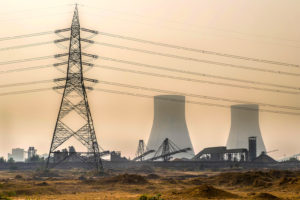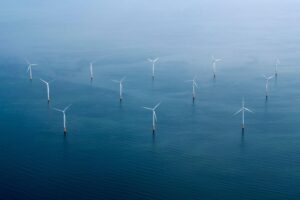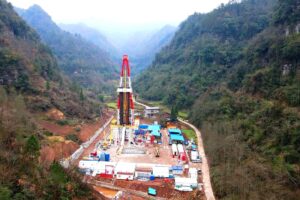Delegates at the 61st meeting of the Intergovernmental Panel on Climate Change (IPCC) in Sofia, Bulgaria have failed to agree on a timeline for the upcoming seventh assessment report.
The week-long meeting saw more than 230 delegates from 195 member governments revisit an unresolved topic from the previous meeting in January – finalising the timeline for the IPCC’s seventh assessment report (AR7) cycle.
AR7 will be the IPCC’s latest round of reports summarising the most recently published climate science.
First published in 1990, the assessment reports typically take 6-7 years to complete. AR6’s concluding “summary for policymakers” was published in March last year.
Many countries said in Sofia that they favoured an accelerated timeline, in which all three “working group” reports would be completed by June 2028. This deadline would allow the findings to inform the UN’s second global stocktake, which will gauge progress towards the Paris Agreement goals.
Ahead of last week’s meeting, a group of 40 IPCC authors from developing countries published an open letter arguing that the AR7 reports “can and must” be produced by this date in order to remain policy-relevant.
However, countries including Kenya, India, China and South Africa opposed the accelerated timeline, warning that “haste leads to shoddy work” and saying that raising concerns that the decision was being rushed through.
Ultimately, the decision was delayed. The issue will be picked up again after the AR7 scoping meeting in December.
Delegates in Sofia had more success in agreeing outlines for the special report on “climate change and cities” and the methodology report on “short-lived climate forcers”, both of which will be published in 2027.
Tricky talks in Turkey
Following the completion of its sixth assessment report (AR6) last year, the IPCC’s attention has now turned to its seventh assessment (AR7).
In a four-day meeting in Istanbul in January, which focused on the IPCC’s “programme of work” for AR7, governments decided against adopting a new structure and instead committed to the traditional set of three “working group” reports and a final synthesis report.
Before the Istanbul meeting, governments had already agreed that the AR7 cycle would include a special report on climate change and cities, as well as a methodology report on short-lived climate forcers.
The meeting then saw the addition of a second methodology report on carbon dioxide removal technologies, carbon capture utilisation and storage, plus a revision to the IPCC’s 1994 technical guidelines on impacts and adaptation.
However, while there was agreement between government delegates on the selection of reports, a timeline for their delivery was not agreed.
The majority of countries meeting in Istanbul favoured delivering the working group reports on an “accelerated” timeline, which would see them published by the end of 2028. This would allow the reports to “inform” the UN’s second global stocktake (GST), which will gauge progress towards the Paris Agreement goals.
However, a few countries, including Saudi Arabia, India and China, “strenuously objected” to this timetable, reported the Earth Negotiations Bulletin (ENB), which has unique access to the closed talks.
It reported, for example, that Saudi Arabia “opposed the shorter timeline, saying this would lead to compromised working groups reports both in content and inclusivity”. While China “emphasised that AR7 aims to be inclusive and developing country scientists should be given time to make their contributions”.
As opposition to the accelerated timeline “held fast” – despite the meeting overrunning into a fifth day – no decision was made.
The final “decisions adopted” document instead requested that the IPCC bureau – experts with more managerial roles, including vice and co-chairs – prepare a document “outlining the month and year of delivery on the basis of an AR7 strategic plan, taking into account the different views expressed” in the meeting.
The instruction included an “oblique reference” to taking “into account” the GST, noted ENB. The report, it was decided, would be presented at the Sofia meeting “for consideration and decision”.
Decision delayed
A key goal of the meeting in Sofia last week was to nail down a timeline for AR7. Ahead of the meeting, a group of 40 IPCC authors from developing countries sent a letter arguing that the AR7 reports “can and must” be produced by 2028, in time to inform the second GST report.
On 31 July, former IPCC vice chair Dr Youba Sokona – a co-author of the letter – published a commentary in Climate Home News summarising its main arguments. He argued that “ensuring the IPCC cycle aligns with GST timelines is crucial for maintaining the integrity of international climate cooperation”, adding that, without input from the IPCC, the stocktake “may lack essential southern perspective”.
He also dismissed concerns that accelerating the timeline would compromise the robustness of the reports, or lead to under-representation of developing countries. The article also outlined ways these concerns could be addressed while implementing an accelerated timeline.
Dr Frederieke Otto – a senior lecturer in climate science at the Grantham Institute for Climate Change and the Environment and IPCC AR6 author – tells Carbon Brief that, in her view, the Working Group II (WG2) and III (WG3) reports are “really needed before the GST”.
Typically, the three working group reports focus on “the physical science basis”, “impacts, adaptation and vulnerability” and “mitigation of climate change”.
On the morning of 31 July, Dr Jim Skea – the IPCC chair for AR7 – presented a proposed schedule for AR7. The proposal was requested by the IPCC panel at the 60th session in Istanbul in January. It was developed by the co-chairs of the IPCC working groups and the Task Force on National Greenhouse Gas Inventories (TFI), then reviewed by the IPCC bureau.
Under this schedule, the AR7 cycle would last six-and-a-half years – similar to the fifth and sixth assessment cycles.
In the discussion that followed, a long list of countries supported the schedule as proposed, with many underscoring the importance of feeding into the second GST, according to the ENB’s summary of the entire meeting.
Belize, supported by the US, the Netherlands and the UK, said IPCC reports need to be ready for the Bonn Climate Change Conference in June 2028, according to the ENB. Belize added that “an inclusive cycle is only meaningful if it can feed into the GST”.
Saint Kitts and Nevis argued that the absence of “crucial” IPCC input into the GST would mean the IPCC would lose policy relevance. The country also argued that the schedule for AR7 is “neither compressed nor rushed”, because, while it is shorter than the schedule for AR6, it also contains fewer special reports.
The AR6 cycle included three special reports – on 1.5C of global warming in 2018, then, successively in 2019, on climate change and land, and the ocean and cryosphere.
(Discussions about linking IPCC reports with the GST are long-standing. During 2016-18, the IPCC panel “agreed to draft terms of reference for a task group on the organisation of future work of the IPCC in light of the GST under the Paris Agreement”, according to the ENB.)
Finland argued that “if we want science-based policymaking, the faster we have the next report, the faster policymakers are able to take science-based policy action”, according to the ENB. And many small-island developing nations also “underscored the critical importance of timely reports from small island developing states [SIDS] and less-developed countries”.
Several countries, including Brazil, Peru and the UK, “stressed that inclusivity concerns could be addressed in ways other than an extended timeline”.
However, several countries, including India, Algeria, Kenya, the Russian Federation and South Africa, argued that a longer timeline is needed to ensure “robust, rigorous scientific outputs, and to ensure greater inclusivity”.
India called the proposed schedule “unprecedented,” saying that the fourth and fifth assessment cycles had similar timeframes, but did not include special reports. It also argued that “producing the best science needs time, haste leads to shoddy work and retracted publications”, according to the ENB.
Kenya, supported by India and South Africa, warned that there are “major” gaps in literature on adaptation in Africa. It said that the “short time” between AR7 scoping meetings and the first author meetings may not be sufficient to identify and fill “literature gaps” for the continent.
And South Africa and Saudi Arabia opposed expediting the schedule to feed into the stocktake, suggesting this would not make the IPCC more “policy-relevant,” but more “policy-prescriptive.”
Dr David Lapola is a research scientist at the University of Campinas in Brazil and AR6 contributing author. He tells Carbon Brief that, “while inclusiveness is super important to bring more legitimacy to the process, it also slows down decisions when you have to have the agreement of all members”. He says that it is a “great challenge to imprint more agility to the IPCC decision processes without compromising inclusiveness”.
On the evening of 1 August, Skea “noted how difficult it had been to find a solution that satisfied all delegations” and he proposed to postpone a decision on the timeline until after the AR7 scoping meeting in December 2024.
In a press release published after the meeting closed, the IPCC stated that “at its next plenary in early 2025, the panel will agree on their respective scope, outlines and work plans, including schedules and budgets”.
“While some expressed disappointment about the lack of consensus, others were quick to point out that determining the timeline after the scoping meeting for the working groups is consistent with past practice and the IPCC’s principles and procedures”, says the ENB.
Dr Hannah Hughes is a senior lecturer in international politics and climate change at Aberystwyth University, who has written extensively about the IPCC. She tells Carbon Brief that it is “not surprising” that the decision has been further postponed. She explains that the IPCC is “balancing complex and competing dynamics”.
She adds:
“Delaying the finalisation of the timeline until after the scoping of reports offers the advantage of having a clear sense of the advances in science and the level of urgency in communicating these.”
However, Otto tells Carbon Brief that it will be “difficult to scope without a timeline”. She says that “with the decision postponed, it seems that conflicts could not be resolved, but everything is just postponed”.
What additional reports were discussed in Sofia?
Earlier this year, IPCC held scoping meetings (in Latvia and Australia, respectively) for a special report on climate change and cities and a methodology report on short-lived climate forcers – both of which are due for publication in 2027. The proposals suggested at these meetings were discussed in Sofia.

Special report on climate change and cities
In 2016, the IPCC decided to produce a special report on climate change and cities. A “cities and climate change science conference” was held in Canada in 2018 to “inspire the next frontier of research focused on the science of cities and climate change”. A scoping meeting was held in Latvia over 16-19 April 2024 to develop a proposed outline for the report.
On 27 July in Sofia, Diana Ürge-Vorsatz – IPCC vice-chair and chair of the scientific steering committee (SSC) for the cities report – presented the proposal.
Under the proposal, the report will have five main chapters. The first will provide framing for the report, the second will discuss “trends, challenges and opportunities” in a changing climate and the third will be called “actions and solutions to reduce urban risks and emissions”. The final two chapters will focus on facilitating change and solutions.
Ürge-Vorsatz also suggested a timeline in which authors for the report will be selected by the end of 2024 and the first meetings of lead authors will be held in 2025. The expert review of the first order draft will take place by the end of 2025, and 15-19 March 2027 will see the “approval of the summary for policymakers and acceptance of the special report”.
In Sofia, many countries proposed changes or raised queries, according to ENB. For example, countries including India, South Africa and Malawi questioned how cities are defined. Burundi, Kenya and Mauritius said early warning systems should be given more prominence. And countries including Burundi, Malaysia and Kenya called for a more “balanced consideration of adaptation and mitigation”.
Over the following days, there were multiple more rounds of comments and drafts. For example, India questioned the shift from “loss and damage” to “losses and damages” implemented in one of the drafts, noting IPCC precedents for use of the latter terminology are limited to one document.
Saudi Arabia opposed the use of “net-zero goals” for cities, saying that these are country-level objectives. And Kenya, supported by India and Algeria, “called for improvements in the way adaptation was addressed throughout the outline”, including the removal of a reference to “maladaptation”.
By 31 July, most countries had accepted the proposal. But others – including Saudi Arabia, India and Kenya – were continuing to raise concerns and to call for a chapter-by-chapter discussion of the report outline.
Skea said the situation was “at a crossroads, given the difficulty of opening only a few non-consensual issues without risking an unravelling, and [he] invited the SSC to confer on whether the issues expressed could be somehow incorporated without unacceptable implications”, according to the ENB.
Timor-Leste, supported by the US and the Netherlands, urged countries to reach a compromise in time for the end of the meeting, noting their delegation consists of a single person. But India, Saudi Arabia and Kenya “expressed concern with other delegations’ ‘refusal to engage’ with their concerns”.
A “huddle” was set up to address some of the key concerns and, on 2 August, the delegates approved a draft decision.
Dr Aromar Revi is the founding director of the Indian Institute for Human Settlements and author on multiple IPCC reports. He tells Carbon Brief that the approval of the outline for an IPCC special report on cities is “a historic step that brings the urban and infrastructure transition, up front and centre of the climate action solutions space”.
He adds:
“It has taken almost a decade of preparation by a wide range of urban and climate actors to make this possible, since it was first suggested in 2016 as a special report in the AR6 cycle…
“This report will be especially important to cities and urban areas in Asia, Africa and Latin America and the SIDS, where 90% of the incremental urban population will live over the next 30-odd years, often in informal settlements with poor services and high vulnerability.”
Revi adds that the proposed timescale, which would see the work completed by March 2027, sets a “high bar” for the authorship team.
Prof Lisa Schipper – a professor of development geography at the University of Bonn and IPCC AR6 author – tells Carbon Brief that the cities report “will be a critical meeting point of adaptation, mitigation and development agendas”.
She adds:
“I was happy to see the level of detail in the cities [report] outline. Normally, the IPCC report outlines are a shopping list of topics without any normative framing. This makes it challenging to write the report with a consistent narrative. I think IPCC member countries will find more relatable and usable content in the cities report.”
The report “will be arriving at a crucial time”, adds Dr Zachary Labe – a scientist at the NOAA Geophysical Fluid Dynamics Laboratory, noting that many cities are “leading examples of how to design and implement evidence-based climate action through adaptation and mitigation practices”.
“The calls for nominations of authors are scheduled for release as early as next week,” according to the IPCC press release.
Short-lived climate forcers methodology report
In 2019, the IPCC decided that the TFI should produce a methodology report on short-lived climate forcers (SLCFs) – gases and particulates, such as methane and carbon, that cause global warming, but typically only stay in the atmosphere for less than two decades.
At the 60th session in January 2024, the panel decided to produce the report by 2027. A scoping meeting for the report was held on 26-28 February 2024 in Brisbane, Australia.
On the first day of the 61st session, Dr Takeshi Enoki, the co-chair of the TFI, presented an overview of the group’s recommendations. He suggested a title for the report of “2027 supplement to the 2006 IPCC guidelines for national greenhouse gas inventories: short-lived climate forcers (2027 supplement on SLCFs)”, and said the report would be a supplement to the 2006 guidelines.
They added that the report would be made up of an overview chapter and five “volumes” following the format of the 2006 IPCC guidelines. These five volumes will focus on “general guidance”, the energy sector, industrial processes and product use, the agriculture, forestry and other land use sector, and waste, he said.
However, many countries raised concerns. First, there was disagreement about whether or not to include hydrogen and PM2.5 – particulate matter with a diameter of under 2.5 micrometres – in the report.
China, India, Iraq and Saudi Arabia, among others, argued that they should not be included, as the literature supporting their inclusion is not robust enough, the ENB says. However, it adds that many other countries – including the US, Canada and Chile – supported its inclusion.
Second, the title of the report was called into question. India said that linking the report to the 2006 guidelines “creates a whole new set of obligations and commitments through other channels”. It, along with Saudi Arabia, called for the report to be changed back to a standalone document. However, Denmark, Germany, Spain and Morocco expressed support for the current format.
A series of huddles were held to iron out these disagreements. On 2 August, the delegates agreed to change the name of the report to “2027 IPCC methodology report on inventories for short-lived climate forcers”.

However, in the absence of consensus on the case for including PM2.5 and hydrogen, the panel decided to come back to this discussion in the future.
What else was agreed in Sofia?
Updates on a range of other IPCC activities were also given, including the IPCC scholarship programme, terms of reference for the IPCC publication committee, and progress reports aimed at increasing accountability and transparency in the IPCC process.
Expert meetings
Ahead of the meeting in Sofia, the IPCC had already decided to limit the production of new special reports in line with the reported preferences of IPCC chair Jim Skea, who previously promised that he would strongly resist pressure to produce more reports.
The limited number of special reports was, in part, to allow more time for expert meetings or workshops. On 2 August, working group one co-chair Prof Xiaoye Zhang introduced the options for expert meetings and workshops for AR7, “highlighting the need for cross-working group collaboration”, according to the ENB.
He noted that expert meetings on reconciling land-use emissions and on CO2 removal technologies had been held in July 2024. Another meeting on gender, diversity and inclusivity has already been “tentatively” scheduled for later this year, and a workshop on the IPCC inventory software will be held in late August 2024.
Ahead of the meeting in Sofia, IPCC co-chairs and their working group bureaus had also proposed a range of extra meetings for 2025-26.
IPCC co-chair for working group one – Dr Robert Vautard – outlined the proposal for a meeting on high impacts and tipping points. The proposal suggests that 60 experts meet in April 2025 to “prepare consensus for the working group-specific assessments addressing
this important topic subject to intense research and debates in the community”.
Vautard explained that the meeting would be led by WG1, but include contributions from all working groups. He added that the meeting will receive financial support from the World Climate Research Programme.
Many countries supported this meeting, with Ukraine calling tipping points “the elephant in the room”. However, India opposed the meeting, saying it spans too many topics. And Saudi Arabia said the meeting is not needed as tipping points will be discussed in the WG1 report.
A meeting on “adaptation guidelines, metrics and indicators” was also proposed. Several countries, including Kenya and Saudi Arabia, said adaptation should be a priority in this cycle, according to the ENB
Finally, a meeting on “novel approaches to assessing knowledge on climate change and society’s responses” was suggested. Australia, Chile, France and others expressed support of this meeting, with many highlighting the importance of Indigenous knowledge and collaboration with the Intergovernmental Science-Policy Platform on Biodiversity and Ecosystem Services.
Health, overshoot and science communication were also identified among other key areas of interest for AR7.
Improving inclusivity
“The one issue on which all delegates seemed to agree was the need to enhance the inclusivity of the IPCC’s work in both its process and products,” the ENB says.
WG3 co-chair Prof Joy Pereira stressed that the bureau is committed to AR7 products being inclusive in terms of author representation and literature assessment, and pointed to a document on improving inclusivity in AR7.
The document suggests setting the agenda for the expert meeting on gender, diversity and inclusivity – which is planned in late 2024 or early 2025 – and providing training on inclusive practices for lead authors and contributing lead authors during the first lead author meeting.
Efforts will also be taken to sponsor measures such as internet access and access to literature for IPCC scientists, according to the document.
(Carbon Brief’s analysis on the change in diversity of IPCC authors over the past three decades highlights access to literature as a key barrier for IPCC authors from less wealthy institutions.)
The post IPCC meeting in Sofia fails to agree timeline for seventh assessment report appeared first on Carbon Brief.
IPCC meeting in Sofia fails to agree timeline for seventh assessment report
Greenhouse Gases
DeBriefed 10 October 2025: Renewables power past coal; Legacy of UK’s Climate Change Act; Fukushima’s solar future
Welcome to Carbon Brief’s DeBriefed.
An essential guide to the week’s key developments relating to climate change.
This week
Renewables overtake coal
‘HISTORIC FIRST’: Renewables have overtaken coal to become the world’s leading source of electricity for the first six months of this year in a “historic first”, BBC News said. The analysis, from the thinktank Ember, found the world generated “almost a third” more solar power in the first half of the year, compared with the same period in 2024, while wind power grew by “just over 7%,” reported the Guardian.
HEAVY LIFTING: According to the report, China and India were “largely responsible for the surge in renewables”, while the US and Europe “relied more heavily on fossil fuels,” the Guardian wrote. China built more renewables than every other country combined in the first half of this year, the newspaper added.
CONTINENTAL SHIFTS: A second report from the International Energy Agency (IEA) predicted a “surge” in global wind and solar capacity by 2030, but shaved 5% off its previous forecast, the Financial Times said. The IEA revealed that India is set to become the second-largest growth market for renewables after China, “with capacity expected to increase 2.5 times by 2030”, Down to Earth reported. The IEA also upped its forecast for renewables in the Middle East and north Africa by 23%, “helped by Saudi Arabia rolling out wind turbines and solar panels”, but halved the outlook for the US, the FT noted.
Around the world
- EV BOOM: Sales of electric and hybrid cars made up “more than half” of all new car registrations in the UK last month, a new record, according to data from the Society of Motor Manufacturers, reported BBC News.
- BANKING COLLAPSE: A global banking alliance launched by the UN to get banks to slash the carbon footprint of their loans and investments and help drive the transition to a net-zero economy by 2050 has collapsed after four years, Agence France-Press reported.
- CUTS, CUTS, CUTS: The Trump administration plans to cut nearly $24bn in funding for more than 600 climate projects across the US, according to documents reviewed by the Wall Street Journal.
- PEOPLE POWER: A farmer, a prison guard and a teacher were among those from the Dutch-Caribbean island Bonaire who appeared at the Hague on Tuesday to “accuse the Netherlands of not doing enough to protect them from the effects of climate change”, Politico reported.
400,000
The number of annual service days logged by the US National Guard responding to hurricanes, wildfires and other natural disasters over the past decade, according to a Pentagon report to Congress, Inside Climate News reported.
Latest climate research
- Politicians in the UK “overwhelmingly overestimate the time period humanity has left to bend the temperature curve”, according to a survey of 100 MPs | Nature Communications Earth and Environment
- Fire-driven degradation of the Amazon last year released nearly 800m tonnes of CO2 equivalent, surpassing emissions from deforestation and marking the “worst Amazon forest disturbance in over two decades” | Biogeosciences
- Some 43% of the 200 most damaging wildfires recorded over 1980-2023 occurred in the last decade | Science
(For more, see Carbon Brief’s in-depth daily summaries of the top climate news stories on Monday, Tuesday, Wednesday, Thursday and Friday.)
Captured

The UK’s Climate Change Act, landmark legislation that guides the nation’s response to climate change, is increasingly coming under attack from anti-net-zero right-leaning politicians. In a factcheck published this week, Carbon Brief explained how the UK’s Climate Change Act was among the first comprehensive national climate laws in the world and the first to include legally binding emissions targets. In total, 69 countries have now passed “framework” climate laws similar to the UK’s Climate Change Act, with laws in New Zealand, Canada and Nigeria among those explicitly based on the UK model. This is up from just four when the act was legislated in 2008. Of these, 14 are explicitly titled the “Climate Change Act”.
Spotlight
Fukushima’s solar future
This week, Carbon Brief examines how Fukushima helped to recover from nuclear disaster by building solar farms on contaminated farmland.
On 11 March 2011, an earthquake off the pacific coast of Japan caused 15m-tall waves to crash into the eastern region of Tōhoku, killing 19,500 people and injuring a further 6,000.
In the aftermath, flooding at the Fukushima Daichi nuclear power plant caused cooling systems to fail, leaching radioactive contaminants into the soil and leading to a major nuclear incident.
Some 1,200km2 around the site was restricted and up to 100,000 people were evacuated – in some cases forever.
In the years following, Japan entered a fraught debate about nuclear energy.
In 2010, nuclear power provided 25% of Japan’s electricity, but, in the years following the disaster, its 54 nuclear reactors were taken offline.
Successive governments have fought over reintroducing nuclear power. Today, some 14 reactors are back online, 27 have been permanently closed and another 19 remain suspended. (Japan’s newly-elected prime minister Sanae Takaichi has promised to make nuclear central to her energy strategy.)
Against this backdrop, Fukushima – a prefecture home to 1.8 million people – has emerged as a surprise leader in the renewables race.
In 2014, the Fukushima Renewable Energy Institute (FREA) opened with the twin goals of promoting research and development into renewable energy, while “making a contribution to industrial clusters and reconstruction”.
That same year, the prefecture declared a target of 100% renewable power by 2040.
Contaminated land
“A lot of these communities, I know, were looking for ways to revitalise their economy,” said Dr Jennifer Sklarew, assistant professor of energy and sustainability at George Mason University and author of “Building Resilient Energy Systems: Lessons from Japan”.
Once evacuation orders were lifted, however, residents in many parts of Fukushima were faced with a dilemma, explained Skarlew:
“Since that area was largely agricultural, and the agriculture was facing challenges due to stigma, and also due to the soil being removed [as part of the decontamination efforts], they had to find something else.”
One solution came in the form of rent, paid to farmers by companies, to use their land as solar farms.
Michiyo Miyamoto, energy finance specialist at the Institute for Energy Economics and Financial Analysis, told Carbon Brief:
“The [Fukushima] prefecture mapped suitable sites early and conducted systematic consultations with residents and agricultural groups before projects were proposed. This upfront process reduced land-use conflicts, shortened permitting timelines and gave developers clarity.”
As a result, large-scale solar capacity in Fukushima increased to more than 1,300 megawatts (MW) from 2012 to 2023, according to Miyamoto. Moreover, installed renewable capacity now exceeds local demand, meaning the region can run entirely on clean power when conditions are favourable, Miyamoto said.
Today, aerial pictures of Fukushima reveal how solar panels have proliferated on farmland that was contaminated in the nuclear disaster.

Charging on
Last year, 60% of Fukushima’s electricity was met by renewables, up from 22% in 2011. (The country as a whole still lags behind at 27%.)
And that is set to grow after Japan’s largest onshore windfarm started operations earlier this year in Abukuma, Fukushima, with a capacity of 147MW.
The growth of solar and wind means that Fukushima is already “ahead of schedule” for its 2040 target of 100% renewable power, said Miyamoto:
“The result is a credible pathway from recovery to leadership, with policy, infrastructure and targets working in concert.”
Watch, read, listen
OVERSHOOT: The Strategic Climate Risks Initiative, in partnership with Planet B Productions, has released a four-part podcast series exploring what will happen if global warming exceeds 1.5C.
DRONE WARFARE: On Substack, veteran climate campaigner and author Bill McKibben considered the resilience of solar power amid modern warfare.
CLIMATE AND EMPIRE: For Black history month, the Energy Revolution podcast looked at how “race and the legacies of empire continue to impact the energy transition”.
Coming up
- 12 October: presidential elections, Cameroon
- 13-14 October: Pre-COP, Brasilia, Brazil
- 13-18 October: World Bank Group/IMF annual meetings, Washington DC
- 14-17 October: 2nd extraordinary session of the Marine Environment Protection Committee at the International Maritime Organisation, London
- 15-16 October: Circle of Finance Ministers report
Pick of the jobs
- Buckinghamshire Council, principal climate change officer | Salary: £49,354-£51,759. Location: Aylesbury, Buckinghamshire
- Sustainable NI, sustainable business lead | Salary: £60,000. Location: Belfast, Northern Ireland
- Dialogue Earth, South Asia managing editor | Salary: £1,875 per month. Location: South Asia
DeBriefed is edited by Daisy Dunne. Please send any tips or feedback to debriefed@carbonbrief.org.
This is an online version of Carbon Brief’s weekly DeBriefed email newsletter. Subscribe for free here.
The post DeBriefed 10 October 2025: Renewables power past coal; Legacy of UK’s Climate Change Act; Fukushima’s solar future appeared first on Carbon Brief.
Greenhouse Gases
Guest post: How Caribbean states are shifting climate legislation
The Caribbean region is among the most vulnerable to climate change, despite historically contributing less than half of one percent of global greenhouse gas emissions.
Rising sea levels, extreme heat and more frequent and intense storms – such as the 2024 Hurricane Beryl, which made landfall in Grenada – pose urgent and growing threats to the small island states, coastal nations and overseas territories that comprise the Caribbean region.
With global progress to address climate change still too slow, Caribbean countries are taking matters into their own hands by enacting more robust legislation to help protect against climate risks.
In a new study published in the Carbon and Climate Law Review, we identified 78 climate laws and legally binding decrees across 16 Caribbean states, as well as two constitutional references to climate change and a growing recognition of the right to a healthy environment.
Our analysis suggests that, together, these developments are not only enhancing resilience, but also positioning Caribbean states as influential actors in the global climate arena.
Caribbean climate laws on the rise
Climate governance in the Caribbean has expanded significantly in recent years. In the past decade, countries such as Cuba and the Dominican Republic have embedded climate obligations and programmatic guidelines into their national constitutions.
At the same time, legislative recognition of the human right to a healthy environment is gaining momentum across the region. Six Caribbean nations now affirm the right in their constitutions, while 15 have recognised it through international instruments, such as the UN Council, UN Assembly and the Escazu Agreement, as shown in the figure below.
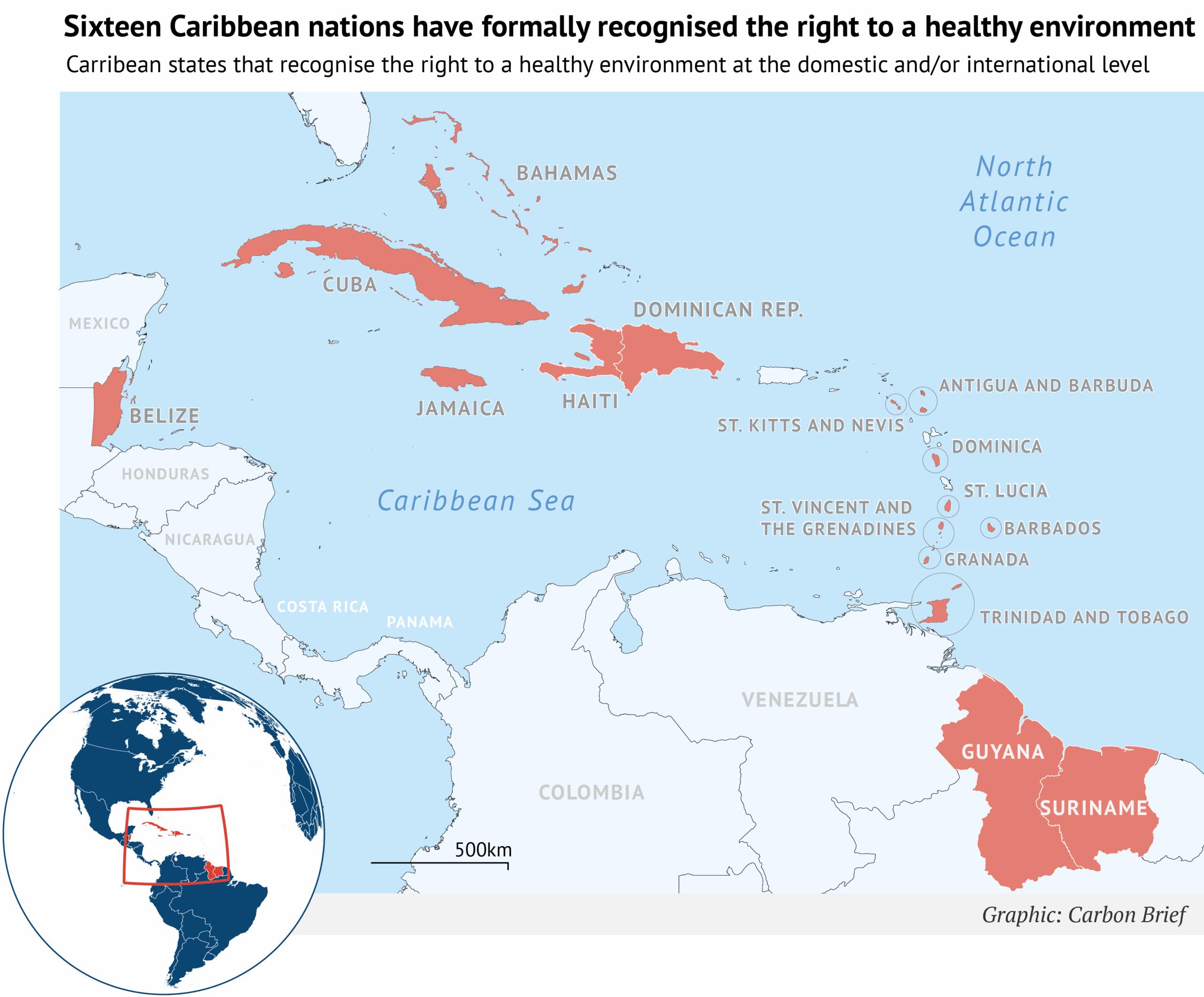
More recently, there has been a notable rise in targeted, sector-specific climate frameworks that go beyond broader environmental statutes.
Saint Lucia stands out as the only country with a climate framework law, or a comprehensive national law that outlines long-term climate strategies across multiple domains. Meanwhile, several other Caribbean governments have adopted climate-specific laws that focus on individual sectors, such as energy, migration and disaster management.
According to our analysis, more than a quarter of climate-relevant legislation in the region – comprising 21 laws and legally binding decrees – now has an explicit focus on climate change, as illustrated in the chart below.
Our research suggests that this represents an ongoing shift in legislative focus, reflecting changes in how climate legislation is being structured in one of the world’s most climate-vulnerable regions.
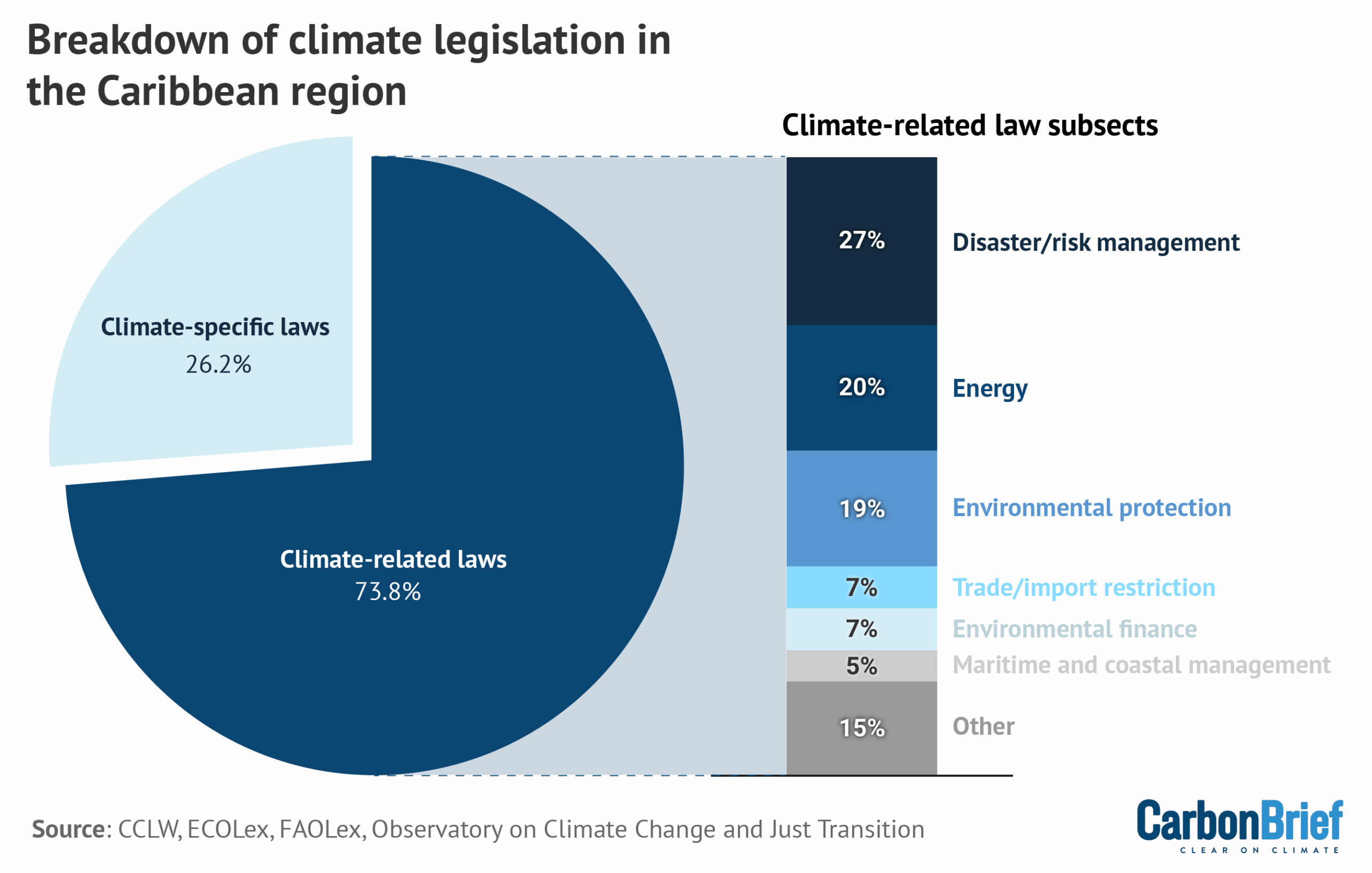
Caribbean nations are also advancing legal reforms to structure and institutionalise climate finance and market mechanisms directly into domestic law, aligned with Article 6.2 of the Paris Agreement.
For example, the Bahamas has introduced provisions for carbon credit trading, while Antigua and Barbuda, Barbados and Grenada have established national climate financing mechanisms to support mitigation and adaptation efforts.
Some states, including Belize and Saint Kitts and Nevis, have incorporated regional bodies such as the Caribbean Community Climate Change Centre – the climate arm of the intergovernmental Caribbean community organisation CARICOM – into national frameworks. This indicates an increasing alignment between regional cooperation and domestic law.
In addition to the influx of regulations specifically addressing climate change, Caribbean nations are also legislating broader environmental issues, which, in turn, could provide increased resilience from climate impacts and risks, as shown in the graph above.
Key trends in these types of climate-related laws include the expansion of disaster risk management governance, which addresses national preparedness for climate-induced weather events or related catastrophes. Likewise, energy law is an increasingly prominent focus, with countries including Antigua and Barbuda and Saint Vincent and the Grenadines integrating renewable energy and energy efficiency goals into national climate governance.
More broadly, many Caribbean nations have adopted wide-ranging and comprehensive environmental laws, many of which were developed in alignment with existing climate commitments. In combination, these legal developments reflect a dynamic and evolving climate governance landscape across the region.
Proactive vs reactive approaches
Despite general alignment with these broader regional trends, our research reveals distinct developmental pathways shaping domestic climate regulation.
In the eastern Caribbean, for example, we saw both proactive, long-term planning strategies and reactive, post-disaster reforms.
Saint Lucia’s multifaceted approach to climate resilience evolved steadily over the course of more than a decade. During this time, the country developed numerous adaptation plans, strengthened cross-sectoral coordination and engaged in institutional climate reforms in areas such as energy, tourism, finance and development.
More recently, the passage of Saint Lucia’s Climate Change Act in 2024 marked a milestone in climate governance, by giving legal force to the country’s obligations under the UNFCCC, the Kyoto Protocol and the Paris Agreement – making Saint Lucia one of the few small island states to incorporate global climate commitments into domestic law.
Our research indicates that this strategy has not only positioned the country as a more climate-resilient nation, but also solidified its access to international climate financing.
In contrast, Dominica’s efforts evolved more rapidly in the aftermath of Hurricane Maria in 2017, which destroyed over 200% of the country’s GDP. The storm’s impacts were felt across the country and hit particularly hard for the Kalinago people – the Caribbean’s last Indigenous community – highlighting the role of socioeconomic disparities in shaping climate vulnerability and resilience.
In response, the government passed the Climate Resilience Act, creating the temporary Climate Resilience Execution Agency for Dominica (CREAD).
Beyond establishing an exclusively climate-focused institution, the act aimed to embed resilience into governance by mandating the participation of vulnerable communities – including Indigenous peoples, women, older people and people with disabilities – in shaping and monitoring climate resilience projects.

As noted in a recent statement by the UN special rapporteur on Climate Change, Dr Elisa Morgera, these frameworks underscore the government’s ambition to become the world’s first “climate-resilient nation.”
Although challenges persist, Dominica’s efforts demonstrate how post-disaster urgency can drive institutional change, including the integration of rights and resilience into climate governance.
Uneven progress and structural gaps
Despite significant progress, our research shows that several key opportunities for climate governance across the Caribbean continue to exist, which could enable improvements in both resilience and long-term ambition.
The region’s legal landscape remains somewhat heterogeneous. While Saint Lucia has enacted a comprehensive climate framework law, the rest of the region lacks similar blanket legislation. This includes some states that entirely lack climate-specific laws, instead relying on related laws and frameworks to regulate and respond to climate-related risks.
Other nations have yet to adopt explicit disaster-risk management frameworks, leaving Caribbean populations vulnerable before, during and after climate emergencies. Most have yet to enshrine the right to a healthy environment at the national level.
Our research suggests that outdated legal frameworks are further limiting progress in addressing current climate risks. Because many of the longer-standing environmental laws in the region were adopted well before climate policy became a mainstream concern, some fail to address the nature, frequency and intensity of modern climate challenges, such as sea-level rise, tropical storms, wildfires, floods, droughts and other impacts.
More broadly, many Caribbean climate laws include limited integration of gender equity, Indigenous rights and social justice. As Caribbean nations such as Grenada and the Dominican Republic begin to link climate resilience with these issues, the region has an opportunity to lead by example.
Ultimately, capacity and resource constraints persist as significant barriers to implementation and adaptation.
The Caribbean region faces debt that exacerbates ongoing development challenges, a burden made heavier by the repeated economic shocks of climate-related disasters. Along with regional debt-for-resilience schemes, increased funding from high-emitting countries to support adaptation measures in climate-vulnerable nations – as endorsed under the Paris Agreement – is likely to be critical to ensuring the region’s climate laws can be executed effectively.
Global implications of Caribbean climate law
Our research suggests that Caribbean countries are outpacing other regions in terms of the scope and ambition of their climate laws. This legislation has the potential to serve as a model for climate-vulnerable nations worldwide.
Continuing efforts in the region show that legal frameworks in the field can not only drive resilience, embed rights and strengthen claims to international finance, but also highlight how regional cooperation and diplomacy can enhance global influence.
These findings demonstrate that innovation in climate law need not wait for action from major emitters, but can instead be led by those on the front lines of climate change.
The post Guest post: How Caribbean states are shifting climate legislation appeared first on Carbon Brief.
Guest post: How Caribbean states are shifting climate legislation
Greenhouse Gases
IEA: Renewables have cut fossil-fuel imports for more than 100 countries
More than 100 countries have cut their dependence on fossil-fuel imports and saved hundreds of billions of dollars by continuing to invest in renewables, according to the International Energy Agency (IEA).
It says nations such as the UK, Germany and Chile have reduced their need for imported coal and gas by around a third since 2010, mainly by building wind and solar power.
Denmark has cut its reliance on fossil-fuel imports by nearly half over the same period.
Renewable expansion allowed these nations to collectively avoid importing 700m tonnes of coal and 400bn cubic metres of gas in 2023, equivalent to around 10% of global consumption.
In doing so, the fuel-importing countries saved more than $1.3tn between 2010 and 2023 that would otherwise have been spent on fossil fuels from overseas.
Reduced reliance
The IEA’s Renewables 2025 report quantifies the benefits of renewable-energy deployment for electricity systems in fossil fuel-importing nations.
It compares recent trends in renewable expansion to an alternative “low renewable-energy source” scenario, in which this growth did not take place.
In this counterfactual, fuel-importing countries stopped building wind, solar and other non-hydropower renewable-energy projects after 2010.
In reality, the world added around 2,500 gigawatts (GW) of such projects between 2010 and 2023, according to the IEA, more than the combined electricity generating capacity of the EU and US in 2023, from all sources. Roughly 80% of this new renewable capacity was built in nations that rely on coal and gas imports to generate electricity.
The chart below shows how 31 of these countries have substantially cut their dependence on imported fossil fuels over the 13-year period, as a result of expanding their wind, solar and other renewable energy supplies. All of these countries are net importers of coal and gas.

In total, the IEA identified 107 countries that had reduced their dependence on fossil fuel imports for electricity generation, to some extent due to the deployment of renewables other than hydropower.
Of these, 38 had cut their reliance on electricity from imported coal and gas by more than 10 percentage points and eight had seen that share drop by more than 30 percentage points.
Security and resilience
The IEA stresses that renewables “inherently strengthen energy supply security”, because they generate electricity domestically, while also “improving…economic resilience” in fossil-fuel importer countries.
This is particularly true for countries with low or dwindling domestic energy resources.
The agency cites the energy crisis exacerbated by Russia’s invasion of Ukraine, which exposed EU importers to spiralling fossil-fuel prices.
Bulgaria, Romania and Finland – which have historically depended on Russian gas for electricity generation – have all brought their import reliance close to zero in recent years by building renewables.
In the UK, where there has been mounting opposition to renewables from right-wing political parties, the IEA says reliance on electricity generated with imported fossil fuels has dropped from 45% to under 25% in a decade, thanks primarily to the growth of wind and solar power.
Without these technologies, the UK would now be needing to import fossil fuels to supply nearly 60% of its electricity, the IEA says.
Other major economies, notably China and the EU, would also have had to rely on a growing share of coal and gas from overseas, if they had not expanded renewables.
As well as increasing the need for fossil-fuel imports from other countries, switching renewables for fossil fuels would require significantly higher energy usage “due to [fossil fuels’] lower conversion efficiencies”, the IEA notes. Each gigawatt-hour (GWh) of renewable power produced has avoided the need for 2-3GWh of fossil fuels, it explains.
Finally, the IEA points out that spending on renewables rather than imported fossil fuels keeps more investment in domestic economies and supports local jobs.
The post IEA: Renewables have cut fossil-fuel imports for more than 100 countries appeared first on Carbon Brief.
IEA: Renewables have cut fossil-fuel imports for more than 100 countries
-
Climate Change2 years ago
Spanish-language misinformation on renewable energy spreads online, report shows
-
Climate Change2 months ago
Guest post: Why China is still building new coal – and when it might stop
-
Climate Change Videos2 years ago
The toxic gas flares fuelling Nigeria’s climate change – BBC News
-

 Greenhouse Gases1 year ago
Greenhouse Gases1 year ago嘉宾来稿:满足中国增长的用电需求 光伏加储能“比新建煤电更实惠”
-
Greenhouse Gases2 months ago
Guest post: Why China is still building new coal – and when it might stop
-

 Climate Change1 year ago
Climate Change1 year ago嘉宾来稿:满足中国增长的用电需求 光伏加储能“比新建煤电更实惠”
-

 Carbon Footprint2 years ago
Carbon Footprint2 years agoUS SEC’s Climate Disclosure Rules Spur Renewed Interest in Carbon Credits
-
Renewable Energy3 months ago
US Grid Strain, Possible Allete Sale










